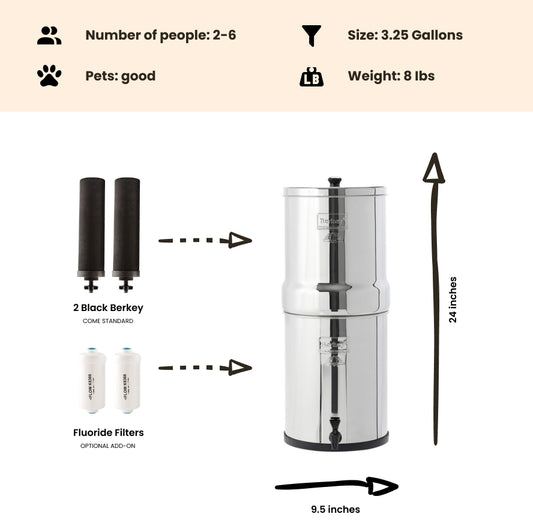
Harmful Effects of Arsenic Exposure Include Irreversible Lung Damage
By Dan DeBaunShare
A recently published study confirms that ingesting drinking water tainted with arsenic can significantly impair lung functioning and cause long-term damage, even at relatively low-moderate levels of exposure. The damage is on a par to that caused by exposure to tobacco smoke over long periods, and smoking exacerbates the situation further, causing even more damage.
“Restrictive lung defects, such as we saw in those exposed to well-water arsenic, are usually progressive and irreversible,” says Habibul Ahsan, MD, MMedSc, Director of the Center for Cancer Epidemiology and Prevention at the University of Chicago Medicine, and co-author of the study. “They can lead over time to serious lung disease.”
The results of the population-based study, which were published online in the American Journal of Respiratory and Critical Care Medicine (August 2013), show that lung damage is yet another health issue to add to the ever increasing list of health effects caused by arsenic, including various forms of cancer, cardiovascular disease, developmental problems and reduced cognitive functioning, and even premature death. The study was conducted in Bangladesh where it is estimated that approximately 77 million people, or roughly half the population of Bangladesh – the eighth most populated country in the world – obtain their drinking water from wells that are contaminated with arsenic.

Lung Exam
While the problem of arsenic in Bangladesh's groundwater is acknowledged, in many other parts of the world, including some regions in the US, much less is known about the levels of arsenic in groundwater or the risk of exposure from drinking contaminated water or contaminated foods. In addition to monitoring drinking water, researchers have now also started screening certain food items, including apple juice and rice syrup, that have higher levels of arsenic than the 10 ppb set as the safe limit for drinking water in the US.
“It is challenging to conduct rigorous biomedical research in a place like Bangladesh that lacks the infrastructure for such projects,” says Ahsan, “but over the last 12 to15 years we have learned how to meet those challenges. We now have a large series of related findings that map out exposures and illustrate the severity of the problem. Our findings reinforce the growing interest in looking more carefully at arsenic-exposure issues in the United States,” he adds.
Bangladesh is comprised of many large river systems bordered by low-lying plains, which makes it vulnerable to flooding, which together with inadequate sanitation has led to many freshwater sources being contaminated with bacteria. Consequently Bangladesh has a history of high rates of infectious disease resulting in a high rates of child mortality – in the '60's more than 250,000 children died annually as a result of waterborne diseases, most of which could have been prevented if they had access to safe drinking water. So, in order to prevent these unnecessary deaths, international humanitarian organizations stepped up their campaign to provide safe drinking water to the people of Bangladesh, installing millions of wells so that people could pump clean, unpolluted water up from deep underground. However, while the water pumped up from underground was free from bacterial pollutants that were prolific in surface water systems, researchers have since discovered that it is contaminated with toxic arsenic, and according to the World Health Organization, represents “the largest mass poisoning of a population in history”.
For this study, the research team assessed the health of 950 participants who complained of respiratory conditions, such as coughing or breathing difficulties to clinic medical staff over a five year period between 2005 and 2010. The researchers assessed the lung function of each patient and recorded their arsenic levels. Patients were divided into three different groups according to their level of exposure, which was determined by measuring the arsenic in their urine as well as the arsenic levels of their drinking water. Doctors then assessed the lung function of these patients using two standard lung-function tests. Both tests revealed that lung damage as a result of arsenic exposure increased as the levels of exposure increased.
The results of the study show that the group of patients that had the lowest level of exposure to arsenic – whose drinking water contained arsenic at levels below 19 ppb – showed no detectable loss of lung function, while the group that was exposed to relatively low doses of arsenic (19-97 ppb) in their drinking water showed a slightly reduced lung function, but this was not considered significant. However, for the group that was exposed to moderate levels of arsenic in their drinking water (> 97 ppb) lung function was significantly reduced, with the test results showing a decrease in lung function of three times less for the first test and six times less for the second. If the patients smoked, the damage was amplified further – roughly 90% of male patients smoked.
“These results clearly demonstrate significant impairment of lung function associated with lower concentrations than previously reported,” explains Ahsan. “Those most affected were older, thinner, less educated and more likely to use tobacco. Many of these people have limited excess lung capacity. It made a significant difference in their lives.”
According to the paper, “this suggests that a large proportion of the country's population are at increased risk of developing serious respiratory disease, including COPD, bronchitis and interstitial lung disease in the future.”
“This is not just a problem for South Asia,” stresses Ahsan. “About 13 million people in the United States get water from a private well that contains more arsenic than the legal limit. And we are becoming more and more aware that exposure through certain foods might be a bigger issue than drinking water. No comparable, large, prospective study has been done in this country.”If you are concerned about the levels of arsenic in your drinking water consider investing in a Berkey water filter. Both the black berkey filters that come standard in the upper chamber and the lower chamber PF-2 fluoride and arsenic filters will remove arsenic that may be lurking in your drinking water. Journal Reference Parvez F., Chen Y., Yunus M., Olopade C., Segers S., Slavkovich V., Argos M., Hasan R., Ahmed A. & Islam T. & (2013). Arsenic Exposure and Impaired Lung Function: Findings from a Large Population-based Prospective Cohort Study, American Journal of Respiratory and Critical Care Medicine, 130712141304005. DOI: 10.1164/rccm.201212-2282OC
-
Regular price $234.00 USDRegular priceUnit price / per
-
Regular price $327.00 USDRegular priceUnit price / per
-
Regular price From $367.00 USDRegular priceUnit price / per
-
Regular price From $408.00 USDRegular priceUnit price / per
-
Regular price From $451.00 USDRegular priceUnit price / per
-
Regular price From $478.00 USDRegular priceUnit price / per
-
Regular price $332.50 USDRegular priceUnit price / per
$350.00 USDSale price $332.50 USDSale

Dan DeBaun
Dan DeBaun is the owner and operator of Big Berkey Water Filters. Prior to Berkey, Dan was an asset manager for a major telecommunications company. He graduated from Rutgers with an undergraduate degree in industrial engineering, followed by an MBA in finance from Rutgers as well. Dan enjoys biohacking, exercising, meditation, beach life, and spending time with family and friends.
~ The Owner of Big Berkey Water Filters















